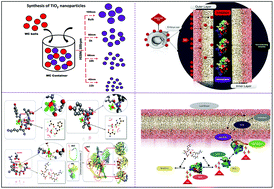当前位置:
X-MOL 学术
›
Toxicol. Res.
›
论文详情
Our official English website, www.x-mol.net, welcomes your
feedback! (Note: you will need to create a separate account there.)
Mechanistic insight into ROS and neutral lipid alteration induced toxicity in the human model with fins (Danio rerio) by industrially synthesized titanium dioxide nanoparticles†
Toxicology Research ( IF 2.2 ) Pub Date : 2018-01-17 00:00:00 , DOI: 10.1039/c7tx00300e Suresh K Verma 1 , Ealisha Jha 2 , Pritam Kumar Panda 1 , Mohana Mukherjee 1 , Arun Thirumurugan 3 , Hardik Makkar 4 , Biswadeep Das 1 , S K S Parashar 5 , Mrutyunjay Suar 1
Toxicology Research ( IF 2.2 ) Pub Date : 2018-01-17 00:00:00 , DOI: 10.1039/c7tx00300e Suresh K Verma 1 , Ealisha Jha 2 , Pritam Kumar Panda 1 , Mohana Mukherjee 1 , Arun Thirumurugan 3 , Hardik Makkar 4 , Biswadeep Das 1 , S K S Parashar 5 , Mrutyunjay Suar 1
Affiliation

|
The toxicological impact of TiO2 nanoparticles on the environment and human health has been extensively studied in the last few decades, but the mechanistic details were unknown. In this study, we evaluated the impact of industrially prepared TiO2 nanoparticles on the biological system using zebrafish embryo as an in vivo model. The industrial synthesis of TiO2 nanoparticles was mimicked on the lab scale using the high energy ball milling (HEBM) method by milling bulk TiO2 particles for 5 h, 10 h, and 15 h in an ambient environment. The physiochemical properties were characterized by standard methods like field emission scanning electron microscopy (FESEM), dynamic light scattering (DLS), X-ray diffraction (XRD) and UV-Visible spectroscopy. In vivo cytotoxicity was assessed on zebrafish embryos by the evaluation of their mortality rate and hatching rate. Experimental and computational analysis of reactive oxygen species (ROS) induction, apoptosis, and neutral lipid alteration was done to study the effects on the cellular level of zebrafish larvae. The analysis depicted the change in size and surface charge of TiO2 nanoparticles with respect to the increase in milling time. In silico investigations revealed the significant role of ROS quenching and altered neutral lipid accumulation functionalised by the molecular interaction of respective metabolic proteins in the cytotoxicity of TiO2 nanoparticles with zebrafish embryos. The results reveal the hidden effect of industrially synthesized TiO2 nanoparticle exposure on the alteration of lipid accumulation and ROS in developing zebrafish embryos. Moreover, the assessment provided a detailed mechanistic analysis of in vivo cytotoxicity at the molecular level.
中文翻译:

通过工业合成的二氧化钛纳米颗粒,深入了解 ROS 和中性脂质改变在带鳍人体模型(斑马鱼)中诱导毒性的机制†
过去几十年来,TiO 2纳米粒子对环境和人类健康的毒理学影响已得到广泛研究,但其机制细节尚不清楚。在本研究中,我们使用斑马鱼胚胎作为体内模型,评估了工业制备的 TiO 2纳米粒子对生物系统的影响。使用高能球磨 (HEBM) 方法,通过在周围环境中研磨块状 TiO 2颗粒 5 小时、10 小时和 15 小时,在实验室规模上模拟 TiO 2纳米颗粒的工业合成。通过场发射扫描电子显微镜 (FESEM)、动态光散射 (DLS)、X 射线衍射 (XRD) 和紫外-可见光谱等标准方法表征理化性质。通过评估斑马鱼胚胎的死亡率和孵化率来评估其体内细胞毒性。对活性氧(ROS)诱导、细胞凋亡和中性脂质改变进行实验和计算分析,以研究对斑马鱼幼虫细胞水平的影响。该分析描绘了TiO 2纳米粒子的尺寸和表面电荷随研磨时间的增加而变化。计算机研究揭示了 ROS 猝灭和中性脂质积累改变的重要作用,这些作用是通过各个代谢蛋白的分子相互作用在 TiO 2纳米颗粒对斑马鱼胚胎的细胞毒性中发挥作用。 结果揭示了工业合成的TiO 2纳米颗粒暴露对斑马鱼胚胎发育中脂质积累和ROS变化的隐藏影响。此外,评估还提供了分子水平上体内细胞毒性的详细机制分析。
更新日期:2018-01-17
中文翻译:

通过工业合成的二氧化钛纳米颗粒,深入了解 ROS 和中性脂质改变在带鳍人体模型(斑马鱼)中诱导毒性的机制†
过去几十年来,TiO 2纳米粒子对环境和人类健康的毒理学影响已得到广泛研究,但其机制细节尚不清楚。在本研究中,我们使用斑马鱼胚胎作为体内模型,评估了工业制备的 TiO 2纳米粒子对生物系统的影响。使用高能球磨 (HEBM) 方法,通过在周围环境中研磨块状 TiO 2颗粒 5 小时、10 小时和 15 小时,在实验室规模上模拟 TiO 2纳米颗粒的工业合成。通过场发射扫描电子显微镜 (FESEM)、动态光散射 (DLS)、X 射线衍射 (XRD) 和紫外-可见光谱等标准方法表征理化性质。通过评估斑马鱼胚胎的死亡率和孵化率来评估其体内细胞毒性。对活性氧(ROS)诱导、细胞凋亡和中性脂质改变进行实验和计算分析,以研究对斑马鱼幼虫细胞水平的影响。该分析描绘了TiO 2纳米粒子的尺寸和表面电荷随研磨时间的增加而变化。计算机研究揭示了 ROS 猝灭和中性脂质积累改变的重要作用,这些作用是通过各个代谢蛋白的分子相互作用在 TiO 2纳米颗粒对斑马鱼胚胎的细胞毒性中发挥作用。 结果揭示了工业合成的TiO 2纳米颗粒暴露对斑马鱼胚胎发育中脂质积累和ROS变化的隐藏影响。此外,评估还提供了分子水平上体内细胞毒性的详细机制分析。











































 京公网安备 11010802027423号
京公网安备 11010802027423号